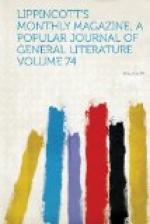There is a certain temerity in undertaking to illustrate a work like “Childe Harold,” which, if it has been read at all, has aroused its own distinct conceptions of scenery in the mind of its reader which must make any ordinary pictures setting off familiar lines tame and insipid. It is the triumph of art when the artist can bring out meanings and beauties in the text hitherto undreamed of; but we acquit the artists of the present book of any failure in that respect, for their intention seems never to have gone beyond amiable commonplace. The little cuts are all pleasant, trim, and, if not suggestive, at least not sufficiently the reverse to be displeasing. The head-pieces to the cantos are extremely good, and the two scenes “There is a pleasure in the pathless woods” and “There is a rapture on the lonely shore” we like sufficiently well to exempt them from the accusation of insipidity.
Happy the poet who lives to see one of the poems he carelessly flung off in early youth come back to him in his old age in such a setting as is here given to Dr. Holmes’s “Last Leaf.” “Just when it was written,” the author says in his delightful and characteristic “Envoi” to the reader, “I cannot exactly say, nor in what paper or periodical it was first published. It must have been written before April, 1833,”—that is, when he was in the early twenties. The poem has always been a favorite, its sentiment suggesting Lamb’s “All, all are gone, the old familiar faces.” It must henceforth be ranked as a classic, for it is the happy destiny of the two artists who have worked together to give it this exquisite setting forth to make its actual worth clear to every reader. They have put nothing into the lines which was not there already, but they have shown fine insight in their choice of subjects and in conveying delicate and far-reaching meanings. They have subordinated—as designers do not invariably do—their instinctive methods and capricious inclinations to a careful study of their subject. The result is—instead of a pretty but chaotic decorativeness interspersed with florid and meaningless exaggerations—a complete and beautiful whole marred by no redundancy or incongruity. Their full play of intelligence brought to bear upon the suggestions of the poet has developed a series of pictures which give occasionally a delightful sense of surprise at their grace and unexpectedness. For example, the three which illustrate
The mossy marbles rest
On the lips that he has prest
In their bloom




